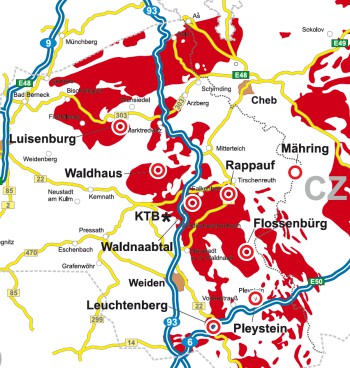
Standort 8: Luisenburg in Wunsiedel
Verwitterungsformen im Granit –
Felstürme, Wollsäcke und Blockmeere
An der Erdoberfläche ist auch der härteste Granit der Verwitterung und
Abtragung unterworfen. Der Wechsel von feucht-warmen sowie eiszeitlichen
Klimaphasen haben die besonderen Verwitterungsformen des
Granits entstehen lassen.

Zvětrávací tvary žuly
I ta nejtvrdší žula je na zemském povrchu vystavena zvětrávání a odnosu. Střídání období vlhkého a teplého klimatu s ledovými dobami umožnilo vznik charakteristických zvětrávacích forem žuly.

Weathering of granite
At the surface even the hardest granite weathers and gets eroded. The periodic change of glacial and interglacial climate in the Tertiary and Quarternary shaped the special weathering forms of the granite.
Bildimpressionen
Trailer Luisenburg (0:35 min)

Foto-Galerie Luisenburg


Tafelstandort in der Karte


Klicken Sie auf den Ortsnamen für mehr Informationen
Tafel 1: Leuchtenberg
Vom Magma zum FestgesteinOd magmatu k pevné hornině
From magma to solid granite
Tafel 2: Pleystein
Granit-Pegmatit – das Beste zum SchlussŽulový pegmatit
Granite pegmatite
Tafel 3: Flossenbürg
Naturwerkstein GranitDekorační kámen žula
Granite as a natural stone
Tafel 4: Mähring
Strahlender Granit – Radioaktivität im SteinZářící žula – radioaktivita v kameni
Radiating granite – radioactivity of the rock
Tafel 5: Grube Rappauf Tirschenreuth
Verwitterter Granit – Kaolin für die PorzellanindustrieKaolin pro porcelánový průmysl
Kaolin for the porcelain industry
Tafel 6: Waldnaabtal
Landschaftsformen im GranitŽulové krajinné útvary
Landscape shaped in granite
Tafel 7: Waldhaus Pfaben
Boden aus Granit – Bedeutung für den WaldPůdy na žule – význam pro les
Soil from granite – significance for the forest
Tafel 8: Wunsiedel Luisenburg
Verwitterungsformen im Granit – Felstürme, Wollsäcke und BlockmeereZvětrávací tvary žuly
Weathering of granite




